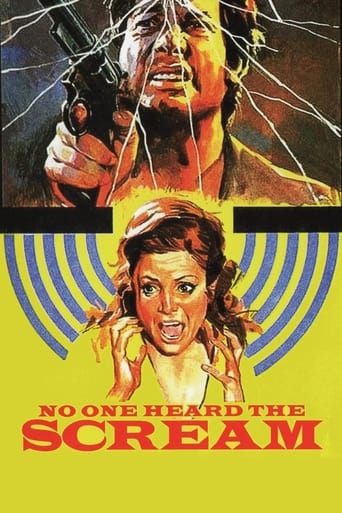jadavix
"No One Heard the Scream" has many of the tropes of a mystery, or even giallo, film. However it largely eschews these genres for most of the run-time, creating less a genre film than a twisted drama about two people pushed to the edge of experience.The protagonist is an expensive mistress for rich men who witnesses her neighbour disposing of his wife's body. The neighbour takes her hostage and the duo go on a trip to the ocean to dump the body in the sea. Along the way, the movie loses its original thriller-aspect and becomes a drama about two people in a strange situation. The actress, particularly, is a problem, so cold and inert. When the movie makes its predictable, if belated, detour into homoeroticism with the introduction of an unnecessary nephew of hers, it's almost a relief to see something on screen other than hardened, impassive faces.There is a romance that feels unlikely and forced, and you are forced to make the conclusion that the openly gay Eloy de la Iglesia just wasn't comfortable shooting romance, love or eroticism between men and women. Perhaps this extended to his casting of the female lead. She looks like someone who was probably a knockout about five years ago. Would men who can afford to keep an expensive mistress use someone her age?Then there is a conclusion, which is also a little hard to swallow, and smacks of the tawdry plot developments we got from the giallo genre. It seems like the movie is doubling back on itself, forgetting the progress it made as an interesting drama, and saying "See! This was a thriller, after all!"I don't know if de la Iglesia ever really made genre pictures; even "The Cannibal Man", notorious Video Nasty though it may be, was perhaps equal parts drama. It also featured an unnecessary young male character as a source of homoeroticism.Perhaps de la Iglesia, who was a superb filmmaker, needed to be encouraged to make dramas and leave behind genre tropes. For the rest of his career, that's what he seemed to do, thankfully.
Red-Barracuda
Before seeing this I was aware of its director, Eloy de la Iglesia, from his more famous film Cannibal Man. I was very impressed with that movie and it is easily one of the best from the infamous video nasty list. No One Heard the Scream was made in the same year as that one and it shares the same lead actor, Vincente Parra. And while this film was not as good as Cannibal Man, it still shows quite clearly that Iglesia is one of the most unheralded Spanish directors. Both films are genre pics with unusually strong acting and underlying themes. They both also share the basic idea of their horrors occurring within apartments, closed off to the rest of the world. No One Heard the Scream goes along a Hitchcockian path, in that we have a woman, Elisa, witnessing a man, Miguel, murdering his wife. The killer catches her and insists that she becomes his accomplice so that she cannot go to the police. The problem is that this innocent starts to develop an attraction for this scheme and soon becomes all too happy to go along with it.The way that the two central characters interact with one and other is quite interesting. The complex nature of their motivations leads to some unusual scenes, such as the part where Elisa shoves Miguel in a lake and runs him over a couple of times in a speedboat. He is completely at her mercy, yet she neither kills him nor runs away and simply lets him back in the boat. It's a bizarre moment but somehow rings true and tells us more about Elisa than anything else in the movie. In her private life she depends on an older man for money in exchange for sexual favours, while she supports a young stud in an opposite arrangement; Miguel fits in uneasily somewhere in between. There are a few suspenseful moments in the first half, while it's the dynamics between the two central characters that makes up the bulk of the second half. Events finalise in a very surprising, yet very acceptable, twist in the tail ending that neatly ties everything together. All-in-all, another quality product from Eloy de la Iglesia.
morrison-dylan-fan
Despite having read a lot of praise for the title over the years,I've found myself constantly having to push Eloy de la Iglesia'a The Cannibal Man to the back of my 'must buy' list.With a poll coming up soon on IMDb's Classic Film board for the best titles of 1973,I was delighted to discover,that I had unknowingly recently picked up a 1973 film directed by Iglesia,which led to me excitingly getting ready to hear the scream become unleashed.The plot:With there only being a few days to go before she is to take her monthly plane trip to London,so as to spend a weekend with her 'sugar daddy',Elisa finds herself suddenly not wanting to make the 'traditional' trip to London,which leads to Elisa phoning up her piece of 'sugar' and telling him that its all over.Being keen to get away from any familiar faces,Elisa decides to leave her holiday villa behind,and to instead move into a low-rent flat,whose tower block only contains a janitor and a loving husband and wife called Miguel and Nuria.After having exchanged pleasantries with Miguel and Nuria,Elisa lays down in bed,and gets set for a quiet weekend.Beginning to fall asleep,Elisa suddenly hears a strange noise which sounds like an object being dragged across the floor just outside her door.Opening the door,Elisa is met with the rather surprising sight of Miguel dropping a dead body down the tower block's lift shaft.Rushing back to her flat and slamming the door shut,Elisa is given the good news by Miguel,that due to it being the weekend,that they are the only 2 residence in the building.Telling him to go away,Miguel decides to reveal to Elisa that he has a gun,and that he will use it unless she lets him in.Carefully opening the door,Elisa is confronted by Miguel holding the gun and telling her to calm down. Realizing that he has all the power in his hand,Miguel tells Elisa that she will be safe,as long as Elisa becomes an accomplice and helps him to properly remove the body.Realizing that she has nowhere else to go,Elisa agrees to Miguel's blood-soaked hands liaison.View on the film:Smartly using the near empty block of flats as a method to physically display the closed off, isolated relationship that Elisa and Miguel place themselves in,the screenplay by co-writer/ (along with Antonio Fos and Gabriel Moreno Burgos)director Eloy de La Iglesia keeps the number of supporting character's to a bare minimum so that the tense relationship between Elisa and Miguel becomes tightly coiled,as Elisa finds herself increasingly becoming an accomplice to the body removal,whilst Miguel finds Elisa's determination to keep her head up high in front of him,to be something that oddly begins to charm Miguel.Giving the title a Giallo-slated shot of Film Noir,the writer's precisely inject supporting characters at crossing points in Elisa and Miguel's relationship,where the murky shadows of their morals get a firmer grip every time one of them leaves the opportunity to separate from the ruthless plans of the other.Making the misconceptions of Elisa's and Miguel's personalities a central themes,the writers deliver a delicately handled,breath taking ending which gradually wraps its venom around Elisa and Miguel,and also cleverly changers the viewer's perceptions on Elisa and Miguel's motives.Teaming up after both of them had worked with La Iglesia on separate occasions,Carmen Sevilla and Vicente Parra each give excellent performances,with Parra showing Miguel's devilishly charming smile to be a cover for his harsh,decisive personality,as Parra shows how far Miguel is willing to go in order to get rid of the body.Joining Parra,the very pretty Carmen Sevilla gives a stunning performance as Elisa,thanks to Sevilla keeping Elisa away from being a two dimensional goody by revealing Elisa to be a Femme Fatale who has a lust for money,whilst also showing,that despite being sickened by his actions,Elisa finds something thrilling in Miguel's body burying games.Made at a time when homosexuality was illegal in Spain,director Eloy de La Iglesia bravely gives the movie strong homo-erotic undertones,by having the camera speed by during Elisa's display of flesh,whilst allowing the camera to stay noticeably paused for moments when the male character's show their skin.Closely working with cinematography Francisco Fraile,auteur La Iglesia reveals a tremendously stylised eye,as La Iglesia and Fraile use jagged,complex tracking shots to show the tightening of Elisa and Miguel's relationship,as La Iglesia superbly uses short,sharp 'dry' shots to guarantee that this scream will be heard.
lazarillo
This is another film by interesting Spanish director Eloy Inglesias. It might be the least interesting of the four films of his I've seen, but it has the same themes that seem to run through all his work--apartment living, voyeurism, domestic murder, and repressed homosexuality. It also features two of his regular actors Vincent Parra ("Cannibal Man) and Carmen Sevilla ("The Glass Ceiling"). Sevilla plays a high-priced call girl who herself is keeping a younger male lover. She comes out the door of her luxury high-rise apartment one day and witnesses her neighbor (Parra) dropping a body,apparently his wife, down the elevator shaft. This may seem like another knock-off of Hitchcock's "Rear Window" (which Inglesias had already "knocked off" in his film "The Glass Ceiling"). But it goes in a different direction when the man kidnaps her at gunpoint and forces her to help him get rid of the body. A strange relationship develops between them.This movie is pretty illogical as Sevilla's character passes up several opportunities to turn her neighbor in, even before she develops a Stockholm-syndrome-type relationship with him. There's a twist at the end which is pretty ridiculous, but certainly unexpected. It's really this absurdity though that marks this as a kind of Spanish giallo (an "amarillo"?) since it lacks the over-top delerium of most Italian-Spanish gialli, and is a little more of a subdued character study. If it were more logical, it would be much more in the realm of Hitchcock or Claude Chabrol than in the realm of the gialli.Inglesias also dials back the homoeroticism a little here. Unlike in "Cannibal Man" there is no intimation that his male characters are closeted homosexuals. Sevilla in some ways may perhaps be a kind of female stand-in for the gay director, and he certainly fetishes the two male actors, who frequently appear shirtless while the beautiful Sevilla (to the disappointment of heterosexual males everywhere) does not. This is probably the weakest of Inglesias' films that I've seen, but it's certainly not bad.


 AD
AD


